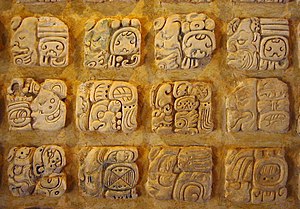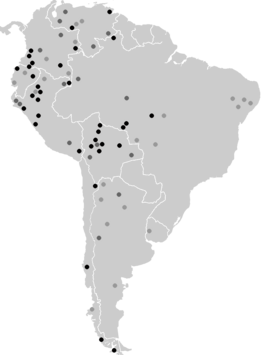Llengües ameríndies
 Glifs maies. | |
| Tipus | grup de llengües i llenguoide |
|---|---|
| Classificació lingüística | |
| llengua humana llengua indígena | |
| Subdivisions | |
| Linguistic areas of the Americas (en) classification of the Indigenous languages of the Americas (en) indigenous language of North America (en) indigenous language of South America (en) | |

Les llengües ameríndies són tots aquells idiomes parlats a Amèrica abans de l'arribada de Cristòfor Colom pels amerindis nord-americans i pels amerindis sud-americans. No corresponen a una sola família lingüística sinó a una agrupació geogràfica. Moltes es van extingir, suplantades per l'espanyol, el portuguès, el francès i l'anglès, les llengües dels colonitzadors. Avui dia moltes llengües indígenes han de lluitar per la seva supervivència i el seu reconeixement, ja que estan lligades a cultures rurals, amb una forta diglòssia i, moltes, sense el suport de l'escriptura.
Classificació de les llengües índies[modifica]
Hi ha diverses classificacions de les llengües d'Amèrica, i és fora de l'abast d'aquest article considerar-les totes; per això, la llista davall consisteix en famílies lingüístiques generalment considerades provades, excepte les mercades específicament com "hipotètiques".
Amèrica del Nord[modifica]
- Família na-dené
- Família atapascana o dené
- Eyak
- Tlingit
- Aquest grup és una branca de la família Dené-ienisseià, que és l'única família lingüística acceptada que uneix llengües del Vell Món i del Nou Món.
- Família salish

- Família takelma-kalapuya (hipotètica)
- Família uto-asteca
- Família kiowa-tano
- Família yuma-chochimí
- Família wakash
- Família pomo
- Família palaihnihana
- Família shahaptiana
- Família wailatpua (cayuse)
- Família chinook
- Llengües aïllades

Centre-sud de Mèxic i l'Amèrica Central[modifica]
Vegeu també l'article: Llengües de Mèxic
- Txibtxa (Amèrica central i Sud-amèrica) (22)
- Comecrudo (Texas & Mèxic) (3)
- Guaicura (8) (també Waikurian)
- Jicaque
- Lenca
- Maia (31)
- Misumalpa
- Mixe-zoque (19)
- Otomang (27)
- Tequistlateca (3)
- Totonaca (2)
- Uto-asteca (33)
- Xinca
- Yuma-cochimí (11)
Aïllades o no classificades (central)[modifica]
- Alagüilac (Guatemala)
- Coahuilteco (EUA: Texas; NE Mèxic)
- Cotoname (NE Mèxic; EUA: Texas)
- Cuitlatec (Mèxic: Guerrero)
- Huetar (Costa Rica)
- Huave (Mèxic: Oaxaca)
- Maratino (NE Mèxic)
- Naolan (Mèxic: Tamaulipas)
- Quinigua (NE Mèxic)
- Seri (Mèxic: Sonora)
- Solano (NE Mèxic; EUA: Texas)
- Tarasco (Mèxic: Michoacán) (també Purépecha o purépetxa, Tarasco)


Amèrica del Sud[modifica]
- Arauana (8) també Arahuan, Arawá, Arauanes) (†)
- Arawak (Amèrica del Sud i Carib) (60) també Arahuaques, Maipureanes, Maipuran, Maipúrean, Maipureano
- Arutani-Sape (2) també Arutani-sapé)
- Aymara (3) també Jaqi, Aru, Aymara, Jaqaru)
- Barbacoa (8) també Barbacoanas
- Bororoa també Boróroan)
- Botocudo (3) també Aimoré
- Cahuapana (2) també Jebero, Kawapánan, Cahuapananas)
- Cariba (29) també Caribe, Carib
- Catacaoa també Katakáoan (†)
- Chapacura-Wanham (9) també Chapacuran, Txapakúran, Chapakúran)
- Charrua també Charrúan) (†)
- Xibxa (Amèrica Central & Amèrica del Sud) (22)
- Chimú (†)
- Chipaya-Uru també Uru-Chipaya)
- Chocó (10) també Chocoan)
- Cholonan (†)
- Chon (2) també Patagonian)
- Guajibo (4) també Wahívoan) (†)
- Guaykurú també Waikurúan)
- Harákmbut (2) també Tuyoneri)
- Huarpe també Warpe) (†)
- Jirajara (3) també Hiraháran, Jirajarano, Jirajarana) (†)
- Jabutia també Jabutían)
- Jê (13) també Gê, Jean, Jêan, Gêan, Je, Ye)
- Jívaro (4) també Hívaro)
- Kamakana també Kamakánan) (†)
- Karajá
- Katukina (3) també Catuquinan)
- Màku (6)
- Mascoya (5) també Maskóian, Mascoian)
- Mataco-Guaicuru (11)
- Maxakalía també Mashakalían)
- Mosetena també Mosetén)
- Llengües Mura (4)
- Nambiquara (5)
- Otomacoa (2) també Otomákoan) (†)
- Paesa (4)
- Panoa també Pánoan)
- Peba-Yagua (2) també Yaguan, Yáwan, Peban) (†)
- Puinavea també Makú)
- Puria també Purían) (†)
- Quítxua (46)
- Saliva (2) també Sálivan)
- Tacana també Takánan)
- Timotea (2) també Timoteano, Timoteana, Timótean) (†)
- Tinigua (2) també Tiníwan) (†)
- Tucanoa (25) també Tukánoan)
- Tupia (70)
- Witotoitotoan (6) també Huitotoan, Bora-Witótoan)
- Yanomama (4)
- Zamucoa (2)
- Zaparoa (7) també Sáparoan)
Aïllades i no classificades (Sud-amèrica)[modifica]


- Aguano (†)
- Ahuaqué també Auaké, Uruak, Awaké)
- Aikaná (Brasil: Rondônia)
- Andoque (Colòmbia, Perú) també Andoke)
- Andoquero (†)
- Aushiri també Auxira)
- Baena (Brasil: Bahia) també Baenán, Baenã) (†)
- Betoi (Colòmbia) també Betoy, Jirara) (†)
- Candoshi també Maina, Kandoshi)
- Canichana (Bolívia) també Canesi, Kanichana)
- Carabayo
- Cayubaba (Bolívia)
- Chiquitano
- Coeruna (Brasil) (†)
- Cofán (Colòmbia, Equador) també Kofán)
- Cueva
- Culle (Perú) també Culli, Linga, Kulyi)
- Cunza (Xile, Bolívia, Argentina) també Atacama, Atakama, Atacameño, Lipe, Kunsa) (†)
- Esmeralda també Takame) (†)
- Fulnió
- Gamela (Brasil: Maranhão) (†)
- Gorgotoqui (Bolívia) (†)
- Guamo (Veneçuela) també Wamo) (†)
- Guató
- Huamoé (Brasil: Pernambuco) (†)
- Huarpe (Warpe)
- Irantxe (Brasil: Mato Grosso)
- Itonama (Bolívia) també Saramo, Machoto)
- Jeikó (†)
- Jotí (Veneçuela) també Hotí, Waruwaru)
- Kaimbe
- Kaliana també Caliana, Cariana, Sapé, Chirichano)
- Kamsá (Colòmbia) també Sibundoy, Coche, Camsá)
- Kapixaná (Brasil: Rondônia) també Kanoé, Kapishaná)
- Karirí (Brasil: Paraíba, Pernambuco, Ceará) (†)
- Katembrí (†)
- Kawésqar (Alacaluf, Qawasqar, Halawalip, Aksaná, Hekaine)
- Koihoma (Perú) (†)
- Koayá (Brasil: Rondônia) (†)
- Kukurá (Brasil: Mato Grosso) (†)
- Leco (Lapalapa, Leko) (†)
- Lule (†)
- Maku també Macu)
- Malibú també Malibu)
- Mapudungu també Araucanian, Mapuche, Huillice)
- Matanawí (†)
- Mocana
- Movima (Bolívia)
- Munichi (Perú) també Muniche)
- Mutú també Loco)
- Muzo (†)
- Natú (Brasil: Pernambuco) (†)
- Nonuya (Perú)
- Ofayé
- Vell Catío-Nutabe (Colòmbia) (†)
- Omurano (Peru) també Mayna, Mumurana, Numurana, Maina, Rimachu, Roamaina, Umurano) (†)
- Otí (Brasil: São Paulo) (†)
- Pakarara (†)
- Palta
- Panche (†)
- Pankararú (Brasil: Pernambuco) (†)
- Pantagora (†)
- Panzaleo (Equador) també Latacunga, Quito, Pansaleo)
- Patagón
- Pijao
- Puelche també Guenaken, Gennaken, Pampa, Pehuenche, Ranquelche) (†)
- Puquina (Bolívia) (†)
- Resígaro (frontera entre Colòmbia i Perú)
- Rikbaktsá
- Sabela (Equador, Perú) també Auca, Huaorani, Wao, Auka)
- Sechura (Atalan, Sec) (†)
- Salumã (Brasil)
- Tairona (Colòmbia) (†)
- Tarairiú (Brasil: Rio Grande do Norte) (†)
- Taruma (†)
- Taushiro (Perú) també Pinchi, Pinche)
- Tequiraca (Perú) també Tekiraka, Avishiri) (†)
- Teushen (†) (Patagònia, Argentina)
- Ticuna (Colòmbia, Perú, Brasil) també Magta, Tikuna, Tucuna, Tukna, Tukuna)
- Trumai (Brasil: Xingu, Mato Grosso)
- Tuxá (Brasil: Bahia, Pernambuco) (†)
- Urarina també Shimacu, Itukale, Shimaku)
- Vilela
- Wakona (†)
- Warao (Guyana, Surinam, Veneçuela) també Guarao)
- Xokó (Brasil: Alagoas, Pernambuco) també Shokó) (†)
- Xukurú (Brasil: Pernambuco, Paraíba) (†)
- Yaghan (Xile) també Yámana)
- Yaruro també Jaruro)
- Yuracare (Bolívia)
- Yuri (Colòmbia, Brasil) també Jurí) (†)
- Yurumanguí (Colòmbia) també Yurimangui, Yurimangi) (†)
Bibliografia[modifica]
- Boas, Franz. (1911). Handbook of American Indian languages (Vol. 1). Bureau of American Ethnology, Bulletin 40. Washington: Government Print Office (Smithsonian Institution, Bureau of American Ethnology).
- Boas, Franz. (1922). Handbook of American Indian languages (Vol. 2). Bureau of American Ethnology, Bulletin 40. Washington: Government Print Office (Smithsonian Institution, Bureau of American Ethnology).
- Boas, Franz. (1929). Classification of American Indian languages. Language, 5, 1-7.
- Boas, Franz. (1933). Handbook of American Indian languages (Vol. 3). Native American legal materials collection, title 1227. Glückstadt: J.J. Augustin.
- Bright, William. (1973). North American Indian language contact. In T. A. Sebeok (Ed.), Linguistics in North America (part 1, pp. 713-726). Current trends in linguistics (Vol. 10). The Hauge: Mouton.
- Bright, William. (1984). The classification of North American and Meso-American Indian languages. In W. Bright (Ed.), American Indian linguistics and literature (pp. 3-29). Berlin: Mouton de Gruyter.
- Bright, William (Ed.). (1984). American Indian linguistics and literature. Berlin: Mouton de Gruyter. ISBN 3-11-009846-6.
- Brinton, Daniel G. (1891). The American race. New York: D. C. Hodges.
- Campbell, Lyle. (1997). American Indian languages: The historical linguistics of Native America. Nova York: Oxford University Press. ISBN 0-19-509427-1.
- Campbell, Lyle; & Mithun, Marianne (Eds.). (1979). The languages of native America: Historical and comparative assessment. Austin: University of Texas Press.
- Goddard, Ives (Ed.). (1996). Languages. Handbook of North American Indians (W. C. Sturtevant, General Ed.) (Vol. 17). Washington, D. C.: Smithsonian Institution. ISBN 0-16-048774-9.
- Goddard, Ives. (1999). Native languages and language families of North America (rev. and enlarged ed. with additions and corrections). [Map]. Lincoln, NE: University of Nebraska Press (Smithsonian Institute). (Updated version of the map in Goddard 1996). ISBN 0-8032-9271-6.
- Gordon, Raymond G., Jr. (Ed.). (2005). Ethnologue: Languages of the world (15th ed.). Dallas, TX: SIL International. ISBN 1-55671-159-X. (Online version: http://www.ethnologue.com).
- Kaufman, Terrence. (1990). Language history in South America: What we know and how to know more. In D. L. Payne (Ed.), Amazonian linguistics: Studies in lowland South American languages (pp. 13-67). Austin: University of Texas Press. ISBN 0-292-70414-3.
- Kaufman, Terrence. (1994). The native languages of South America. In C. Mosley & R. E. Asher (Eds.), Atlas of the world's languages (pp. 46-76). London: Routledge.
- Key, Mary R. (1979). The grouping of South American languages. Tübingen: Gunter Narr Verlag.
- Loukotka, Čestmír. (1968). Classification of South American Indian languages. Los Angeles: Latin American Studies Center, University of California.
- Mason, J. Alden. (1950). The languages of South America. In J. Steward (Ed.), Handbook of South American Indians (Vol. 6, pp. 157-317). Smithsonian Institution Bureau of American Ethnology bulletin (No. 143). Washington, D.C.: Government Printing Office.
- Migliazza, Ernest C.; & Campbell, Lyle. (1988). Panorama general de las lenguas indígenas en América. Historia general de América (Vol. 10). Caracas: Instituto Panamericano de Geografía e Historia.
- Mithun, Marianne. (1999). The languages of Native North America. Cambridge: Cambridge University Press. ISBN 0-521-23228-7 (hbk); ISBN 0-521-29875-X.
- Powell, John W. (1891). Indian linguistic families of America north of Mexico. Seventh annual report, Bureau of American Ethnology (pp. 1-142). Washington, D.C.: Government Printing Office. (Reprinted in P. Holder (Ed.), 1966, Introduction to Handbook of American Indian languages by Franz Boas and Indian linguistic families of America, north of Mexico, by J. W. Powell, Lincoln: University of Nebraska).
- Powell, John W. (1915). Linguistic families of American Indians north of Mexico by J. W. Powell, revised by members of the staff of the Bureau of American Ethnology. (Map). Bureau of American Ethnology miscellaneous publication (No. 11). Baltimore: Hoen.
- Rowe, John H. (1954). Linguistics classification problems in South America. In M. B. Emeneau (Ed.), Papers from the symposium on American Indian linguistics (pp. 10-26). University of California publications in linguistics (Vol. 10). Berkeley: University of California Press.
- Sapir, Edward. (1929). Central and North American languages. In The encyclopædia britannica: A new survey of universal knowledge (14 ed.) (Vol. 5, pp. 138-141). London: The Encyclopædia Britannica Company, Ltd.
- Sebeok, Thomas A. (Ed.). (1973). Linguistics in North America (parts 1 & 2). Current trends in linguistics (Vol. 10). The Hauge: Mouton. (Reprinted as Sebeok 1976).
- Sebeok, Thomas A. (Ed.). (1976). Native languages of the Americas. New York: Plenum.
- Sherzer, Joel. (1973). Areal linguistics in North America. In T. A. Sebeok (Ed.), Linguistics in North America (part 2, pp. 749-795). Current trends in linguistics (Vol. 10). The Hauge: Mouton. (Reprinted in Sebeok 1976).
- Sherzer, Joel. (1976). An areal-typological study of American Indian languages north of Mexico. Amsterdam: North-Holland.
- Sturtevant, William C. (Ed.). (1978-present). Handbook of North American Indians (Vol. 1-20). Washington, D. C.: Smithsonian Institution. (Vols. 1-3, 16, 18-20 not yet published).
- Voegelin, Carl F.; & Voegelin, Florence M. (1965). Classification of American Indian languages. Languages of the world, Native American fasc. 2, sec. 1.6). Anthropological Linguistics, 7 (7): 121-150.
- Voegelin, Carl F.; & Voegelin, Florence M. (1977). Classification and index of the world's languages. Amsterdam: Elsevier. ISBN 0-444-00155-7
Enllaços externs[modifica]
| A Wikimedia Commons hi ha contingut multimèdia relatiu a: Llengües ameríndies |


